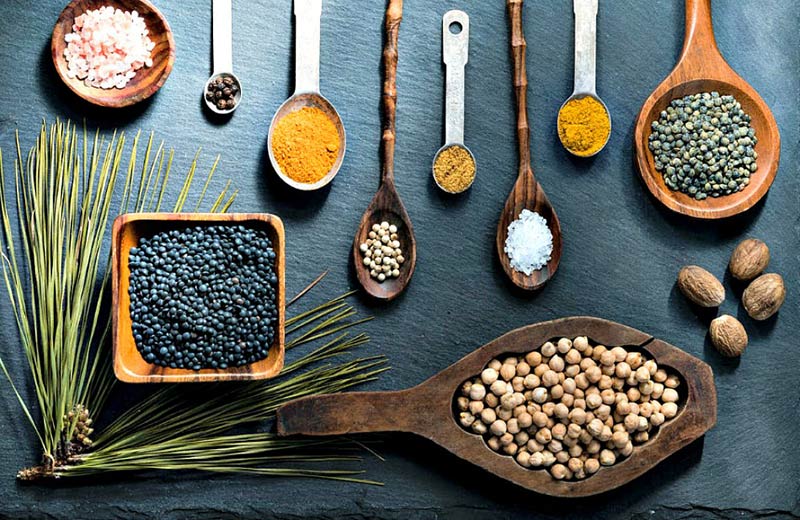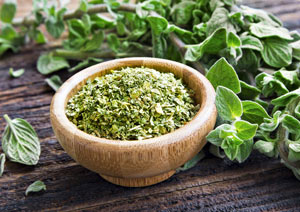
Photo by C Colourin Public domain (CC by 2.0)
www.publicdomainpictures.net/en/view-image.php?image=212117&picture=food-kitchenspices-spoon-wood
We’ve compiled a list of 12 spices essential to creating unique and flavorful dishes and included some helpful advice for each herb or spice. In no particular order…

1. Ginger
Ginger products are made from dried or fresh ginger root (a rhizome, actually) and the mildly hot, bitingly sweet spice can be used in many ways, both in sweet and savoury dishes. Mix up a delicious ginger marinade for fish, chicken or vegetables. It’s a natural for stir fries and Asian dishes—soy sauce, garlic, and ginger are very happy together. Try adding crystallized ginger to chocolate or shortbread to make a dessert that’s both spicy and sweet. Enjoy ginger cookies, ginger-infused chicken, ginger beer, ginger candy or make a tea with honey to treat what ails you.

2. Cumin
Cumin comes from the dried seeds of an annual plant in the parsley family. Earthy, pungent and slightly nutty, cumin is a commonly used spice in Asian, Indian, Middle Eastern and Mexican cuisines. It is sold as either whole or ground. We suggest roasting cumin seeds to release its full flavour. Cumin enhances the flavour of many types of dishes is frequently included in curry powders. Use it to season chicken, beef, pork, sausages, soups, stews, eggs, beans, lentils, chickpeas, potatoes, couscous, chilli and more.

3. Basil
Basil plants bear leaves that have a strong aroma that might remind you of mint and cloves. While the leaves’ fragrance is powerful, the taste is more subtle. It is used extensively in Italian and Thai cooking. Basil is rich, spicy and slightly peppery— a lovely culmination of flavors making it delightful to use fresh, dried or frozen. Basil is wonderfully versatile because the leaves can be eaten fresh or cooked. Fresh leaves add extra zing to salads and can double up as a garnish. It greatly enhances the taste of veal, chicken, fish or lamb. When used with mild vegetables such as cauliflower, potatoes, cabbage, squash, eggplant or zucchini, basil accentuates the taste factor. Soups, stews, sauces and marinades with basil add zip and zest. Many cooks like to use basil in tomato dishes, especially Italian sauces; the two flavors complement one another where the sum is greater than the parts. Lemon basil is often used in chicken dishes and desserts.

4. Bay Leaf
These aromatic, woodsy-tasting leaves are typically sold dried but if you have an opportunity to buy fresh or frozen, go for it. Choose leaves with a rich green color. Add whole bay leaves to soups, stews, and marinades and remove before serving. Bay leaf is often used to season long-cooking dishes like soups, stews, and braises, but it can also enhance the flavor of quicker-cooking dishes like rice, risotto or a pasta sauce. The key is to have at least a little liquid for the bay to infuse and heat to get the process going. Though bay leaf is used most widely in Mediterranean cooking, it has become an established seasoning in Indian, Middle Eastern and many European cuisines. It’s also one of the herbs used in a classic French bouquet garni.

5. Turmeric
Tumeric is a spice native to Southeast India that comes from the rhizome of a plant in the ginger family. It is sometimes available fresh but is usually sold dried and ground in powder form. Turmeric has antioxidant properties and a host of many other health benefits. It boasts a peppery warm flavor. Its intense colour mimics that of saffron and is a great budget-friendly substitute when looking to achieve the rich yellow hue in any dish — be careful to not get it on your clothes! It’s a popular Indian spice, a must-have for giving curries a full-bodied flavor and in Malaysia cooks use it to flavor a popular chicken dish called kapitan. It is used in Sri Lanka’s Colombo powder. Turmeric is what colors American processed cheese, mustard, butter, yellow cake mix, popcorn and dozens of other products.

6. Black Peppercorns
Black pepper is one of the most versatile and widely-used spices in the world. Available in several varieties, peppercorns are actually the dried berries of the pepper plant (piper nigrum), native to Asia. The same plant also produces white and green peppercorns. For the best flavor always choose whole peppercorns over pre-ground versions: the flavor of freshly ground or cracked pepper makes the small effort in preparation well worth it. Black pepper’s uses are almost endless, adding both heat and that extra bit of dimension to many dishes. It is widely used in the making of beef jerky. It’s mostly used to assist with preservation because beef jerky contains sauces and sugars to help it stay fresh and full of flavor. A great bonus is the peppercorns gives it a smokey flavor. Try coating meats with crushed peppercorns or add it to warm beverages such as chai tea. Add to fresh fruit for an extra kick or mix with other spices for a flavor-enhancing blend.

7. Oregano
With a hearty, robust flavor, oregano is ideal in dishes that contain other equally strong or acidic ingredients, providing that this-is-Italian flavor for pizza or your favorite spaghetti and meatballs. It’s readily available both fresh and dried. Fresh oregano has a milder, more delicate flavor. The two most common types of oregano are Greek and Mexican. Mexican oregano looks similar to Mediterranean oregano, but Mexican has a stronger resinous and earthy flavor. (The plants are from different but closely related botanical families.) Mexican oregano has a stronger, more robust flavor.

8. Mustard
Mustard seeds need to dry roast or fry and pop in hot oil to release their full potential. In stir fries, toss them in oil with finely minced aromatics like ginger and garlic or curry leaves. The seeds’ spiciness makes them choice additions to rubs and seasoning blends. When cooked in oil the taste of mustard seeds will remain subtle, adding a less pungent flavor to things like curry pastes, sauces, or stews.After toasting, mustard seeds mellow out and can be incorporated into a sauce or dressing to provide a nutty, earthy flavor as well as a bit of texture.They’re also used for pickling. There are three varieties of mustard seeds: yellow, brown and black — each can be used to make your own mustard condiment.

9. Cinnamon
Super tasty and versatile, cinnamon is used in both sweet and savory dishes. The whole quills or cinnamon sticks can be added to stews, used to flavor curries, mulled wine, punches, added to stewing fruit and rice dishes (including rice pudding). It’s distinctive taste and aroma is enjoyed solo (think cinnamon rolls) and in combination with other warm spices like cloves, nutmeg, and allspice (in cakes, cookies and fruit crisps, breads, pies, puddings and more). In savory dishes, it may appear in soups, sauces, chutneys, curries, catsup, pickles, squash, potatoes, green beans, red beets, applesauce, vinegars, meat, fish and poultry glazes and marinades and grains. Try it in hot drinks like cider, mulled wine coffee, tea and cocoa too. Cinnamon is widely used in spice mixes for savory dishes in Asian, Middle Eastern and North African cuisines, for example in tagines.

10. Rosemary
Rosemary has a piney aroma and a distinctive sharp flavor. It can be used fresh or dried. Rosemary is an incredibly powerful herb and can easily overwhelm a dish if you use too much. It’s best to start with the minimum called for in a recipe and work your way up to taste. Also, remember that the rosemary flavor will gain strength the longer a dish cooks, particularly those with a lot of liquid. Rosemary has a place in everything from meat and chicken, to vegetables, soups, baked goods, and even cocktails. It can go into a marinade or braise and get worked into a compound butter to melt over the finished dish. Rosemary is a natural accompaniment to lamb, its bracing flavor a perfect match for the inherent gaminess of lamb.

11. Cardamom
Cardamom is an alluring spice with a seductive aroma. Its bright green pods conceal black pearls of flavor which liven up a wide array of dishes. It is a common ingredient in Indian spice mixtures such as curries, often blended with things like cumin, coriander, ginger, garlic and turmeric. Cardamom is also used extensively in the Middle East to flavor coffee and it often appears in Scandinavian breads, cookies, and other baked goods. Cardamon pairs well with fruits, either in sweet or savory recipes. Cardamon and orange, for example, in a glaze for meat, or cardamom and peach with baked pork, or a cardamom spiked apple sauce.

12. Coriander seed
The small, creamy brown seeds of the coriander plant give dishes a warm, aromatic and slightly citrus flavour totally different to fresh coriander leaves. They are commonly used in Indian cooking as well as featuring in Asian, Middle Eastern and Mediterranean dishes. Although the difference in flavor between ground and whole coriander is nuanced, the powder works best for incorporating flavor seamlessly into doughs and batters, while the texture of whole or gently cracked seeds complements meat rubs or condiments like gremolata or chutney. Coriander’s pleasant yet subtle flavor can enhance sweet and savory dishes of any origin, from yeasted doughs and cookies to sauerkraut and racks of lamb.

what spices and herbs that give strong aroma in beef and chicken
how to make it to give us sweet test and aroma
Please can you still get the aroma for basil back after drying
what amount and types can you add of culinary spices/herbs to one litre of tea with milk to make easy drinkable.
Best dry spice for heat to add to bake goods & how much? Dont want it hot but love heat especially sweet heat or just spicy
Wonderful ideas. You have done an excellent job.
Thank you